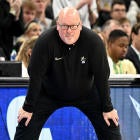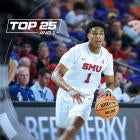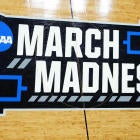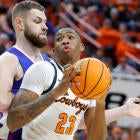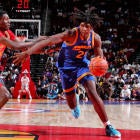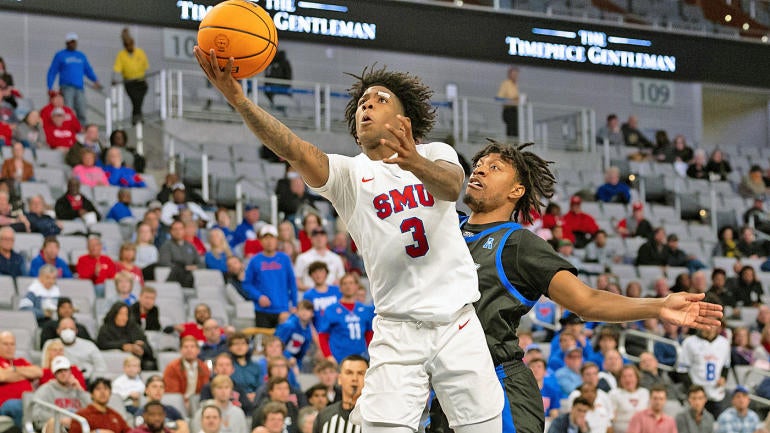
Over 1,000 Division I men's basketball players entered the transfer portal this offseason, and nearly all have found their new home for this season, whether it was the NBA, a new college team or a return to their program.
CBS Sports' David Cobb tracked his top 25 transfers all offseason. Transfers can be tricky to evaluate, but the top ones are likely to be significant contributors. With that, let's take an in-depth look at David's top five transfers and exactly what they'll bring to their new teams this season.
One thing before we dive too deep: All points per possession numbers are via Synergy Sports. Included in the calculation are possessions in which a player shoots and makes, shoots and misses, goes to the free throw line or turns the ball over.
1. Kendric Davis (Memphis)
The reigning AAC Player of the Year at SMU, Kendric Davis does just about everything at a very high level, but there are two areas where he is truly exceptional: on spot-up shots and in isolation. Last year, Davis scored 1.28 points per possession on spot ups (97th percentile in D-I) and 1.015 points per possession in isolation (86th percentile). Only one other player -- Liberty star Darius McGhee -- scored 1.2 PPP and 1 PPP in those two categories (min. 90 possessions), respectively.
As for what he'll bring to Memphis specifically, Davis' isolation scoring stands out. He's a joy to watch: ball-on-a-string handle, great acceleration, terrific body control and jaw-dropping individual shot-making. He also drew fouls at the highest rate of any AAC player last year.
Memphis, meanwhile, scored an awful 0.698 points per isolation possession, 276th in Division I. The Tigers' best offense came in transition, and as a result, they played at the fastest pace in D-I last year. While Davis is good everywhere offensively, he'll be a revelation in half-court settings.
2. Nijel Pack (Miami)
Nijel Pack was clearly the best shooter in the transfer portal. He was also arguably the best shooter in the country last season. Pack scored an absurd 1.469 points per spot-up possession, best by any major-conference player last year (min. 50 possessions) and best by a Big 12 player since Synergy started tracking it in 2005-06.
| Player | Year | PPP on Spot Ups |
|---|---|---|
Nijel Pack (KSU) | 2021-22 | 1.469 |
Adam Flagler (BAY) | 2020-21 | 1.448 |
Tyrese Haliburton (ISU) | 2019-20 | 1.431 |
Brady Heslip (BAY) | 2013-14 | 1.424 |
Rodney McGruder (KSU) | 2010-11 | 1.424 |
Pack has terrific recognition of opposing teams' defenses, which helps him identify not just when to move off-ball but how to move off-ball and space the floor with a purpose. Let's take a look at three examples.
The first is my favorite. As soon as Pack recognizes his defender has slightly misplayed the screen, he gets beyond the 3-point line, sets his feet and scores. It's a tiny mistake by the defense, but Pack has the basketball IQ, range and quick release to take advantage of it. In the second clip, he subtly moves just a few feet, allowing his teammate to make a cross-court pass that wouldn't have been possible had Pack stayed in the corner. In the third clip, notice how Pack is ever so slightly backing up as the ball gets passed to him, giving him just enough space to rise and fire over two closeout defenders. If he doesn't create that extra space, he may not get that shot off. Pack is constantly working smarter -- not necessarily harder -- to be in the right spot.
Pack can play point guard and shooting guard, but is best suited for the latter. While he's not particularly explosive off the bounce, returning star guard Isaiah Wong is. The moment defenses help on Wong, Pack will find open space on the perimeter and make opponents pay.
3. Tyrese Hunter (Texas)
The surface-level offensive numbers for Hunter, the Big 12 Freshman of the Year, weren't super impressive. He shot under 40% from the floor and 27% on 3-pointers and had the second-most turnovers per game in the Big 12. But there are plenty of reasons Hunter was one of the most sought-after players in the portal and why he'll be an important contributor at Texas.
Let's start on the defensive end. He allowed just 0.714 points per possession as the primary defender last year, which ranked in the 85th percentile in Division I last year, and that's in large part because he creates a ton of turnovers. Hunter forced a turnover on 20.8% of his possessions as the primary defender, 13th out of 962 Division I players who defended at least 200 possessions and best in the Big 12. It's worth noting Hunter's now-teammate Marcus Carr was second in the Big 12. Expect Texas to force a lot of turnovers.
Hunter's combination of physicality, quickness, competitiveness and active hands make him a terror for opposing guards.
Offensively, the shooting can be streaky, but the playmaking is very much there. Hunter's assist rate of 32.1% was second among Big 12 players last season, and he is especially good coming off screens. He can make a variety of passes -- one or two-handed, looking or no-look, on the move or standing still -- which makes for some super fun highlights (especially the first one below).
Rim-running bigs will love Hunter's passing. Carr will love not having to guard opposing teams' best player and handle the ball all game. And Texas fans will love a player who can attack opponents on both ends of the court.
4. Isiaih Mosley (Missouri)
When it comes to players who simply get buckets, Isiaih Mosley isn't just one of the best, but he's one of the most efficient, too. Last year, Mosley became the only player to average at least 20 points on 50/40/90 shooting splits in the past decade. That alone makes him a huge boost for a Missouri team experiencing big changes under new coach Dennis Gates.
The Tigers return just one of their top five scorers from last year's team. Mosley will be the guy, and lucky for Missouri, he's a great guy to have. Last year, he was one of just three players to average at least one point per possession as a pick-and-roll ball handler, in isolation and as a spot-up shooter (min. 50 possessions). But where he can really fill it up is in isolation. Only Detroit Mercy star Antoine Davis had more isolation points than Mosley's 143 last season. Check out the variety of ways Mosley scores in isolation as part of his 40-point outing at Loyola Chicago.
Mosley has the size, strength, handle and shooting ability to pile up points in a hurry. While he doesn't finish at the rim very often, his variety of floaters and pull-ups allow him to be an effective driver, and his accuracy from deep off the dribble leads to scoring binges. Expect some big games from him as Missouri navigates a transition season.
5. Fardaws Aimaq (Texas Tech)
After a promising freshman season at Mercer in 2018-19, Fardaws Aimaq transferred to Utah Valley, redshirted, and then became the first player ever to win WAC Player of the Year and WAC Defensive Player of the Year in the same season. He won WAC Defensive Player of the year again last season. In short, there's a reason he had a long list of suitors before ending up at Texas Tech.
On offense, Aimaq's biggest improvement has been the development of his jump shot. In his first two college seasons combined, he took 13 jump shots in half-court settings. Last year, he took 62, making 25 for a respectable 40% clip. He is quite comfortable stepping out well beyond the 3-point line in addition to working out of the post. Last year, Aimaq was one of just three players with at least 200 points on post ups and 60 points on jump shots, joining Michigan star Hunter Dickinson and Fresno State standout Orlando Robinson.
Aimaq also grabbed 13.6 rebounds per game last year, second in Division I behind Kentucky's Oscar Tshiebwe, and allowed just 0.722 points per possession as the primary defender, 81st out of 962 players who defended at least 200 possessions. He does a nice job of using his size to his advantage without fouling, and while he'll have to improve as a pick-and-roll and pick-and-pop defender, he is very good defending the post, a strength of Texas Tech's top-ranked defense last year, too.













